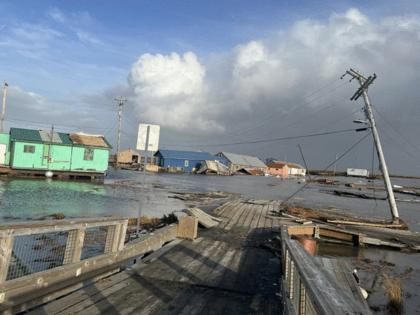Officials for years knew about flood risks in rural Alaska. The recent storm illustrated how little they have to show for it
Published in News & Features
ANCHORAGE, Alaska — For decades, state and federal officials have been warning about the kind of catastrophic damage wrought by the storm that hit Western Alaska over the weekend.
But those predictions, along with hundreds of millions of dollars in federal funding for mitigation efforts, were not enough to prevent dozens of homes from floating away when struck with the remnants of Typhoon Halong, leaving one person dead and hundreds in emergency shelters.
The federal Government Accountability Office reported in 2003 that most Alaska Native villages were at risk because of flooding and erosion.
In 2007, former Gov. Sarah Palin established the Alaska climate change "sub-Cabinet" to develop and implement a comprehensive climate change strategy. Its 2010 report called for more government coordination to prepare for and mitigate "increased coastal erosion that is threatening a number of coastal villages."
But the zigzagging politics of state and federal administrations since then have hampered efforts to fortify Alaska Native communities against destructive storms.
After years of on-and-off planning and funding to prepare for the impacts of climate change — changing, sometimes diametrically, with every federal and state administration, and shared among a run-on list of agencies — many Alaska Native villages remain vulnerable to flooding exacerbated by melting sea ice, coastal erosion and storm surges.
The climate change sub-Cabinet assembled by Palin was quietly disbanded by her successor, Gov. Sean Parnell. The next governor, Bill Walker, formed a new climate change commission in 2017.
That commission submitted its recommendations — including for more planning resources to be dedicated to adaptation and relocation of communities threatened by flooding — months before Walker was voted out of office and replaced with Gov. Mike Dunleavy, who promptly disbanded the commission in 2019.
"One of the challenges facing at-risk communities is the lack of a formal federal or State policy on climate change response, especially as it relates to relocation," the commission wrote in its 2018 report, which was never implemented.
Dunleavy has not led any statewide climate change-focused efforts preemptively addressing its impact on dozens of villages across the state.
"Oftentimes, they call these incidents an 'act of God,'" Dunleavy said when asked this week whether he thought the storm was caused by climate change and if the state should more proactively plan for future, similar storms.
Even as Dunleavy stepped away from efforts to examine environmental changes in Alaska communities, state agencies under his tenure joined with the Alaska Native Tribal Health Consortium to conduct coastal risk assessments in remote Alaska Native communities.
Those risk assessments followed a 2019 statewide threat assessment submitted to the federal Denali Commission, ranking villages based on the threats they faced from erosion, flooding and thawing permafrost.
"We are very aware that no entity has all the resources and expertise to handle all the resilience needs of communities and that an 'all hands on deck' approach is needed to provide assistance," said Sally Russell Cox, who manages the state's resilience and planning program in the Division of Community and Regional Affairs.
In recent years, assessments had been prepared by the state for the communities hardest-hit by the recent storm, including Kwigillingok and Kipnuk. But Cox said that the recent flooding in those communities exceeded the state's predictions by 3 feet and 2 feet, respectively.
"This highlights the need for quality, community-specific data and robust, data-driven risk assessments," Cox said. "Far too many Alaskan communities lack the crucial information required to mitigate the natural hazards they face."
Last year, the village of Kipnuk secured $20 million in federal funding to mitigate erosion and fortify its infrastructure against storm surges, only for it to be rescinded. A spokesperson for the federal Environmental Protection Agency on Thursday defended the decision, saying "due to the proactive cancellation of this grant, $20 million of hardworking U.S. tax dollars are currently sitting in the U.S. treasury instead of swept into the Kuskokwim River."
Under President Donald Trump, hundreds of millions of dollars in funding opportunities approved by Congress for Alaska Native communities have been frozen or outright canceled, including the Kipnuk grant.
But even when they are not frozen or canceled, past investments to address environmental threats in Alaska Native villages have not yielded the desired effect. According to a Government Accountability Office report from 2022, federal agencies budgeted about $200 million between 2016 and 2020 "to build resilience to environmental threats in these villages, but much more needs to be done to protect them."
"Of the more than 30 federal programs that could help, most are hard for Native villages to access," the report stated.
© 2025 the Alaska Dispatch News (Anchorage, Alaska). Visit www.adn.com. Distributed by Tribune Content Agency, LLC.







Comments